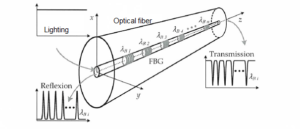 A team of researchers offers a new application of fiber Bragg grating sensors (FBG sensors) in the construction and characterization of Micro Pattern Gaseous Detector. Such a FBG sensing system includes 144 gas electron multiplier chambers of about 0.5 m2 active area each. It should be noted that FBG technology has been applied in high energy physics only for high precision positioning and re-positioning fiber sensors due to their benefits (low cost, easy installation, low space consumption). Nowadays the most common application of fiber Bragg gratings remains the use for very accurate strain measurements in material studies.
A team of researchers offers a new application of fiber Bragg grating sensors (FBG sensors) in the construction and characterization of Micro Pattern Gaseous Detector. Such a FBG sensing system includes 144 gas electron multiplier chambers of about 0.5 m2 active area each. It should be noted that FBG technology has been applied in high energy physics only for high precision positioning and re-positioning fiber sensors due to their benefits (low cost, easy installation, low space consumption). Nowadays the most common application of fiber Bragg gratings remains the use for very accurate strain measurements in material studies.
Now FBG technology is used as flatness and mechanical tensioning sensors employed to the wide GEM foils of the GE1/1 chambers. FBG sensor array allows detecting the optimal mechanical tension applied and characterizing the mechanical tension that should be applied to the foils. A new application of FBG sensors has been already tested and demonstrated great results that can determine a standard assembly procedure and possible future developments.
Fiber Bragg gratings are considered to be a type of distributed Bragg reflector, developed by a short segment of optical fiber that enables one to reflect certain wavelengths of light and transmit all others. The operating principle of FBG sensors is based on “the creation of a periodic variation in the refractive index of the fiber core, which generates a wavelength-specific dielectric mirror”. Thus, the FBG sensing system can be applied as a strain measurement device because changes in fiber Bragg gratings lead to various light frequency responses.
One more application of FBG sensors in GEM chamber construction includes the opportunity to be applied as a load gauge for accurate measurement of the tensile load employed to the foils, of the various layers, at the same moment. The thing is that this FBG application plays a crucial role in the case of the GE1/1 chambers because the foils are stretched through screwing nuts with a dynamometric screwdriver during their assembly procedure, therefore, it is necessary to know accurately how much to strain the foils to escape to stretch them too much.
The testing of fiber Bragg grating sensors consist of proper stretching of the GE1/1 GEM stack, then the researchers removed a single stretching screw from the chamber and replaced it with an eyelet screw with installed stainless steel wire applied to set various weights. Additionally, it was necessary to add weights in different steps until they applied load achieves in the fiber Bragg gratings facing the eyelet the same response as when stretching of the GEMs occurs by the traditional screw.
Finally, the technology of FBG sensors is regarded as a highly reliable glue-less technique that offers the correct tensioning of the three GEM foils. The correct tension across the GEM stack leads to uniform gaps resulting in the required performance of the detector. Moreover, FBG sensors operate successfully as load gauges for accurate detection of the used stretching force to GEM foils.
Optromix is a manufacturer of innovative fiber optic products for the global market. The company provides the most technologically advanced fiber optic solutions for the clients. Optromix produces a wide range of fiber optic devices, including cutting-edge customized fiber optic Bragg grating product line and fiber Bragg grating sensor systems. Moreover, Optromix is a top choice among the manufacturers of fiber Bragg grating monitoring systems. If you have any questions, please contact us at info@optromix.com

